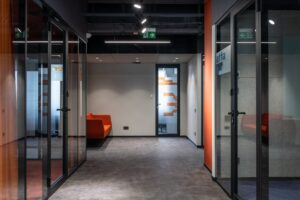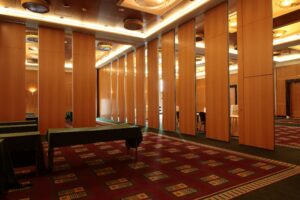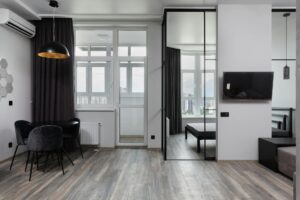Space Optimization with Operable Walls: Transforming How We Utilize Our Environments
In today’s dynamic world, where flexibility and adaptability are paramount, traditional, fixed-wall spaces are becoming increasingly limiting. This is where operable walls, also known as movable walls or folding partitions, emerge as a revolutionary solution for space optimization. These innovative systems offer a multitude of benefits, transforming the way we utilize and experience our environments.
Unlocking Flexibility: Adapting Spaces to Evolving Needs
The core strength of operable walls lies in their ability to create a more versatile and adaptable space. Unlike their fixed counterparts, operable walls can be effortlessly moved to reconfigure a room on-demand. This allows users to seamlessly transition between different layouts, catering to diverse needs and functions.
Imagine a large conference room that can be effortlessly divided into smaller breakout sessions with the touch of a button or a swipe on a mobile app (in the case of automated systems). This flexibility empowers businesses to maximize the functionality of a single space, eliminating the need for dedicated rooms for various purposes.
Similarly, in educational institutions, operable walls can transform a large lecture hall into smaller classrooms for focused learning. This adaptability caters to various class sizes, teaching styles, and collaborative activities.
Even residential spaces can benefit from operable walls. Imagine a studio apartment where a single wall can be used to create a separate sleeping area or a home office during the day.
Maximizing Floor Space: Efficiency Without Compromise
Traditional fixed walls often create underutilized pockets of space. Operable walls, on the other hand, optimize floor space utilization by eliminating the need for dedicated storage areas for bulky, movable partitions. These systems typically operate vertically along tracks mounted on the ceiling, freeing up valuable floor space for furniture, equipment, or simply creating a more open and airy feel.
In commercial settings, where maximizing space efficiency is crucial, operable walls can significantly enhance productivity and functionality. Open floor plans, facilitated by operable walls, encourage collaboration and communication while allowing for the creation of private areas for focused work when needed.
Beyond Functionality: Enhanced Acoustics and Privacy
One might assume that the flexibility of operable walls comes at the cost of soundproofing. However, advancements in technology have led to the development of operable walls with exceptional acoustic properties. These walls incorporate advanced sealing technology that effectively mitigates noise transmission, creating quieter and more private environments within an open space.
This is particularly beneficial in environments like offices, where noise distractions can significantly impact productivity. Operable walls can be used to create dedicated meeting spaces or soundproof areas for focused work, ensuring optimal levels of privacy and sound control.
Natural Light and Sustainable Design
Operable walls, particularly those with glass panels, play a significant role in promoting sustainable design principles. By facilitating the flow of natural light throughout a space, they reduce the need for artificial lighting, thereby minimizing energy consumption and associated costs. Additionally, operable walls can enhance ventilation options, especially when integrated with operable windows or ventilation systems. This can further contribute to energy efficiency by reducing reliance on air conditioning systems.
Aesthetic Appeal: Transforming Spaces with Style
Operable walls are not just functional; they can also be a stunning design element. Modern operable walls come in a variety of materials, finishes, and styles, seamlessly integrating with existing aesthetics. Glass panels offer a sleek and contemporary look, while fabric panels add a touch of warmth and texture. Additionally, operable walls can be customized with artwork, graphics, or writable surfaces, further enhancing their visual appeal and functionality.
Applications: A Versatile Solution for Diverse Environments
The benefits of operable walls extend far beyond commercial office spaces. Here are some examples of how operable walls can be utilized in various settings:
- Educational Institutions: Create flexible learning environments, dividing large lecture halls into smaller classrooms or breakout areas.
- Hospitality Venues: Reconfigure banquet halls to accommodate events of varying sizes, or create private dining areas within a larger space.
- Retail Stores: Offer a dynamic shopping experience by creating designated areas for promotions or seasonal displays.
- Healthcare Facilities: Establish temporary partitions for patient privacy or create flexible treatment areas.
- Residential Spaces: Separate sleeping areas, home offices, or living areas within open floor plan apartments or homes.
Considerations for Implementing Operable Walls
While operable walls offer a multitude of advantages, there are a few factors to consider before implementation:
- Space Requirements: Ensure adequate ceiling height and track space for proper wall operation.
- Budget: Costs can vary depending on the size, materials, and level of automation chosen.
- Acoustic Needs: Select walls with appropriate soundproofing properties based on your specific requirements.
- Aesthetics: Choose a style and material that complements the existing design of the space.
By carefully considering these factors, you can maximize the benefits of operable walls and create a truly versatile and adaptable space.




